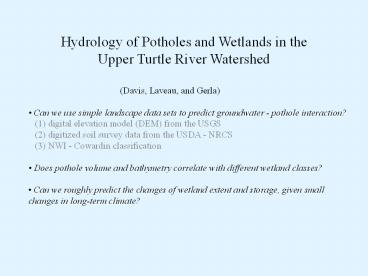Example Curves - PowerPoint PPT Presentation
1 / 31
Title: Example Curves
1
Hydrology of Potholes and Wetlands in the Upper
Turtle River Watershed
(Davis,
Laveau, and Gerla) Can we use simple landscape
data sets to predict groundwater - pothole
interaction? (1) digital elevation model (DEM)
from the USGS (2) digitized soil survey data
from the USDA - NRCS (3) NWI - Cowardin
classification Does pothole volume and
bathymetry correlate with different wetland
classes? Can we roughly predict the changes of
wetland extent and storage, given small changes
in long-term climate?
2
ephemeral
semi-permanent
seasonal
alkali
figure taken from Euliss and others (1999)
3
(No Transcript)
4
Relative changes in the surface area of five
potholes, upper Turtle River watershed
5
Groundwater - Pothole Interaction
6
unknowns
Application of Darcys Law and the Continuity
Principle (water balance)
knowns
7
Results of a transient groundwater flow model
using a DEM profile for the initial heads. An
increasingly deep and smooth water table
indicates decreasing groundwater recharge, flux,
and discharge through the profile.
8
model output (added by Chris Laveau)- input
parameters computational record comparison to
wetland maps statistical analysis model output
characteristics spatial arrays shallow
water table indicator elevation of the
water table recharge - discharge
9
DEM
10
model water table
11
ephemeral and seasonal
NWI wetlands
semi-permanent and permanent
12
model results - water table lt 0.5 m
13
NWI wetlands over model shallow water table
14
hydric soils over model shallow water table
15
groundwater flux - model output
16
Results from the modeling effort - The best
match was obtained between hydric soils and model
output for shallow (lt0.5 m) water table Less
correlation was noted between the model and NWI
wetlands. Most areas that do not correlate appear
to be NWI ephemeral and seasonal wetlands (PEMA
and PEMC) Groundwater discharge tends to be
strongly focused along the Turtle River and large
permanent and semi-permanent lakes
17
Models that describe the relationship between
pothole area and volume
(for potholes up to 70 hectares)
- Hayashi, M., Van der Camp, G. 2000. Simple
equations to represent the volume-area-depth
relations of shallow wetlands in small
topographic depressions, Journal of Hydrology
23774-85 - Wiens, L.H. 2001. A surface area-volume
relationship for prairie wetlands in the upper
Assinboine River basin, Saskatchewan, Canadian
Water Resources Journal 26503-513 - Wise, W.R., Annable, M.D., Walser, J.A.E.,
Switt, R.S., Shaw, D.T. 2000. A wetland-aquifer
interaction test, Journal of Hydrology 227257-272
18
V 467,537e-149.75(Area/Circumference)
19
Simple regressions provide surprisingly good
correlation between surface area of potholes and
their volume. But these results provide little
to no insight into bathymetry shoreline and
littoral characteristics origin developmental
history physical evolution relationship to
ecology
20
Do varying shapes of pothole profiles relate to
hydrological conditions?
Can simple classifications, such as the USFWS
Cowardin system relate to profiles? Does this
and similar classifications contain more
information?
21
Hydrological group A (indicating ephemeral
saturation)
Hydrological group C or F (indicating
more persistent or longer seasonal water)
note the difference in the volume --- for a given
depth, potholes with greater curvature will have
greater volume.
22
Half-width profile can be fitted by 2nd order
polynomial c2 x2 - c1 x b In the first case,
where the pothole takes on a smooth V shape, c2
becomes zero and the fit is linear With
increasing curvature, the magnitude of c2
increases The actual profile measurements and
curve fits for pond 2 (PEMC) follow.
23
(No Transcript)
24
(No Transcript)
25
(No Transcript)
26
(No Transcript)
27
(No Transcript)
28
Work In Progress - 2nd order polynomial fit
accounts for most variation in profile shape 89
potholes have been measured, providing over 400
half-width profiles initial results suggest that
greater curvature correlates with increasing
water persistence PEMA ---gt PEMC ---gt
PEMF results will lead to an empirical method
of using NWI maps to improve estimates of pothole
volume
29
Pothole Water Budget and Climate
Variability (adapted from Wigley and Jones, 1985,
Nature 314149-151) PWL (pothole water loss)
P (watershed) - ET (watershed) Define a
pothole water loss ratio w PWL w P
then ET (1-w) P Suppose a long-term
departure from initial P and ET occurs P1
p P0 and ET1 e ET0 With some
rearranging, r PWL1 p - (1 - w) e
PWL0
w where r represents a fractional
increase in pothole water loss
30
Pothole - 10,000 m2 water loss 0.01 m/day
Watershed - 5 x 106 m2
Precipitation 0.0014 m / day (0.5 m / yr)
Find the equilibrium storage loss ratio w w
pothole water loss/precipitation 100 m3/day
/ 7,000 m3/day Assume precipitation 5 and ET
by 2 across the watershed p 1.05 e
1.02 r 1.05 - (1 - 0.014) 1.02
3.2 0.014
Even with these small long term changes, the
relative change in pothole water loss r becomes
3.2, suggesting that the pothole will need to
cover three times more area to maintain its water
balance
31
Some possible directions to continue the work
Can we use a simple model of climate variability
to predict the expansion and contraction of
wetlands? Does the basin shape correlate to
water persistence? If so, do groundwater
interaction and water persistence control the
shape of the pothole basin? Using NWI data,
can the prairie pothole region be broken into
discrete zones and subprovinces? If so, can
we develop general maps of basin profiles and
water budgets?































